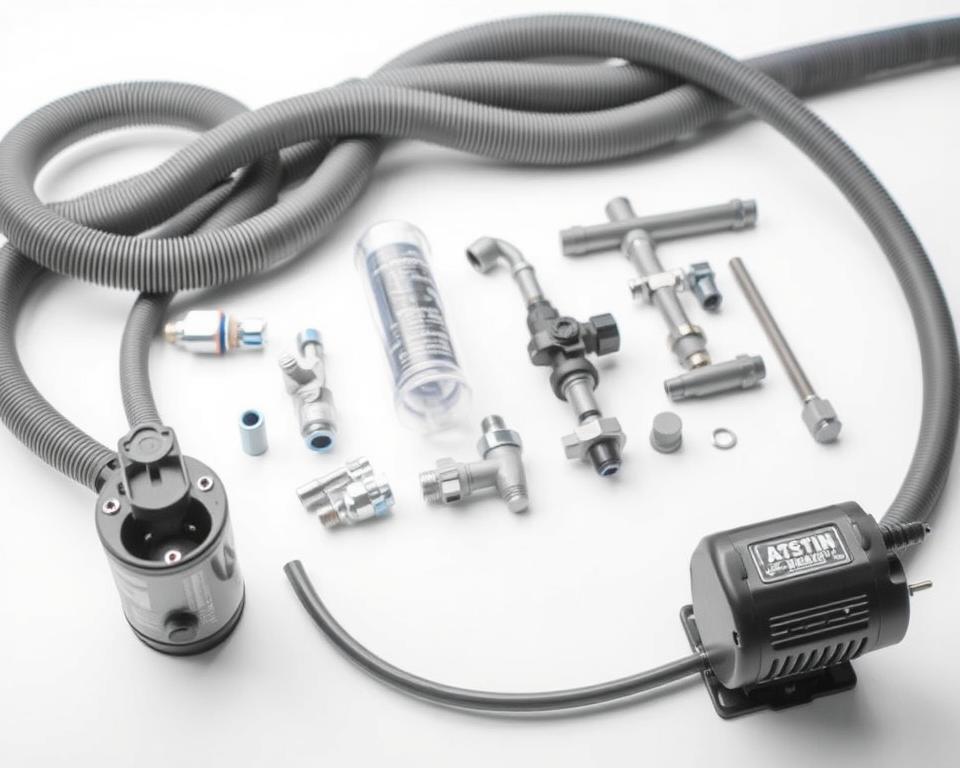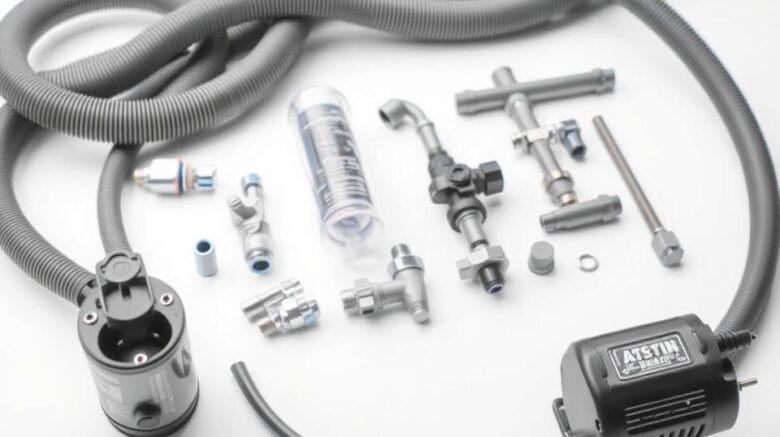Motorhome Water Tank & Pump: Definitive Manual
Have you ever pondered what keeps an on-the-road adventure stress-free? It’s all about your RV water Tank & Pump. From heading to national parks or just a weekend retreat, getting a grip on your RV’s water system is paramount. The following guide we unpack the basics: the parts, upkeep, and strategies for trouble-free travel. Understanding each component, from the linework to reservoir filling, secures water is always at your disposal during your excursions – RV septic pumping near me.
Principal Ideas
- Understanding the RV water system elevates your travel enjoyment.
- The RV fresh-water Tank & Pump are crucial for a reliable water supply.
- Regular servicing protects the lifespan of your RV plumbing.
- Knowing the right way to top up your reservoir correctly can avert future issues.
- Diagnosing your water Pump can save you from sudden problems.
Breaking Down RV Water Systems
RV water systems consist of two primary parts: the potable-water setup and the used-water mechanism. The clean-water circuit features several core components like the storage Tank, pressure Pump, and faucets, mirroring domestic plumbing but adapted to the mobile needs of living on the move.
Ensuring drinkable water is essential for the system’s performance. It safeguards the safety of all passengers. It’s important to keep the RV plumbing in top shape through regular maintenance – including proper drainage to prevent leaks and other issues. Timely inspections help RV enthusiasts sidestep water-related headaches during their journeys.

The Role of the RV Water Tank
The RV water Tank is indispensable for a smooth journey. It houses the clean water necessary for drinking, cooking, and cleaning. The capacity of this container changes with each RV model, impacting how much water can be stored – and this directly influences how long you can stay off-grid before requiring a refill.
Ensuring the RV storage Tank hygienic is critical. Regular cleaning prevents harmful contaminants, so the water stays safe for use. Neglecting maintenance can promote bacteria or algae growth, making the water hazardous.
Recognising the RV Tank’s role streamlines water management during trips. Proper upkeep and frequent refills ensure a stress-free experience. It’s crucial to have ample water for all travel needs, ensuring a smooth RV adventure.
Filling Your RV Fresh-Water Tank
Filling your RV water Tank requires attentive action to guarantee it’s done correctly. There are two main methods: gravity filling and pressure filling. Mastering these techniques significantly improves your RV conditions.
Gravity-feed is direct. You just need a food-grade water hose. Hook up this hose to a water source, then to the Tank’s opening, and let gravity do the rest. Be sure to monitor the water level to avoid spills.
Using city pressure involves a city water connection, offering faster fill times. You must use a pressure regulator to control water flow. Attach the hose from the municipal source to your RV. This method ensures speedy and consistent supply to your reservoir.
Choosing method you prefer, follow these key safety tips: Always monitor the fill when filling to prevent overflow, and use clean water to avoid health issues. Mastering these filling and safety techniques will make your RV trips even more enjoyable.
RV Water System: Key Components Explored
The RV Tank-and-Pump combo are vital to any RV’s plumbing system, delivering a consistent and efficient water supply for all your needs. The RV water Pump’s main job is to draw water from the reservoir, ensuring clean water is always on call. That’s key for cooking, cleaning, and showering.
RV plumbing offers different Pump types, each with individual benefits. Diaphragm pumps are popular for their even water pressure, while centrifugal models are loved for ease and efficiency. It’s important to weigh flow rate, noise, and installation ease when picking your Pump.
To conclude, the RV Tank-Pump pair are irreplaceable to your water system’s operation. A dependable Pump guarantees strong pressure and smooth flow, boosting your overall travel experience.
Choosing the Perfect RV Water Pump
Choosing the ideal RV water Pump is essential for your water system’s peak performance. When picking a Pump, weighing several points is crucial for a positive camping experience. Ensuring it fits your RV’s water system is paramount.
Keep these important aspects in mind:
- Flow Rate: Select a Pump with a flow rate that meets your usage requirements. A stronger flow means faster reservoir refills.
- Pressure Ratings: Your RV’s different fixtures determine the needed pressure levels. Pick a Pump whose specs match those needs for smooth operation.
- Noise Levels: Noise can be an issue with some Pumps. For a calm cabin, contrast models for their noise output.
Brands like Shurflo and VEVOR are high on the list for many RVers, providing stand-out perks. A thoughtful assessment of these brands will assist your selection process.
Grasping these factors is not only crucial for the right purchase but also equips DIY enthusiasts with essential know-how for upkeep and replacements.
Hooking Up to City Water for Your RV
Hooking your RV to city water allows for an uninterrupted supply of fresh water, freeing you from just using your Tank. This guarantees a more comfortable camping experience. Ensure to follow proper steps for a trouble-free hookup.
First, locate the city water connection port on your RV. It’s commonly marked by a white or black connector, sometimes tagged for ease. Grab a potable water hose designed for RVs; this kind of hose protects your water safe from contaminants.
It’s essential to attach a pressure regulator before making the connection. This gadget shields your plumbing by moderating the water pressure. With the regulator in place, link the hose from it to the water source.
Once connected, keep an eye on the water pressure. Maintain a steady, gentle flow to avoid hose damage. Check your hoses regularly for any wear or leaks and promptly replace parts as needed.
Following these steps for city hookup improves your camping convenience and helps in maintaining your RV’s condition.
Maintaining Your RV Fresh-Water Tank
Ensuring your RV’s fresh-water reservoir is well cared for is essential for safe, clean water while out on adventures. A sound Tank avoids bacterial growth and contamination. To begin, periodically sanitise the Tank: combine water with a bit of bleach for an effective residue-free clean.
It’s crucial to look for leaks and manage Tank pressure. Regular checks can detect problems early, avoiding expensive fixes. A solid schedule keeps the water system in excellent health.
To optimise maintenance, use a checklist:
- Check water levels and quality regularly.
- Sanitise the Tank bi-annually with a bleach solution.
- Inspect for leaks in the reservoir.
- Monitor Tank pressure and Pump function.
- Flush the Tank to clear any sediment buildup.
RV Water Pump Problem-Solving
RV water Pump troubles can be vexing, derailing travel plans unexpectedly. Encountering strange noises, dealing with low pressure, or facing complete Pump failure are frequent problems. Understanding how to troubleshoot them can greatly improve your trips.
If you hear odd sounds from your Pump may signal a problem. Start : check for loose connections and secure them. When there’s low water pressure, inspect hoses and fittings for leaks. Even a small leak can dramatically affect flow, early troubleshooting is critical.
If your Pump fails completely, test electrical connections. Start with examining the Pump’s fuse. If the fuse is fine, continue diagnosing for wear or damage.
A systematic approach isolates and resolves water system issues. Regular maintenance and inspection guarantee easier journeys.
| Issue | Possible Cause | Suggested Solution |
|---|---|---|
| Strange Noises | Loose connections | Tighten fittings |
| Low Pressure | Leaky hoses/fittings | Find & seal leaks |
| Pump Failure | Electrical fault | Check fuse/wiring |
| No Water Flow | Blocked lines | Flush obstructions |
Best Practices for Efficient RV Water Use
Travelling in isolated areas typically entails limited water access. Wise use in your RV is vital. By embracing smart conservation tactics, you not only manage resources well but also boost camping satisfaction.
To make the most of water while travelling, try these tips:
- Take brief showers – aim for under five minutes.
- Install water-saving fixtures like low-flow showerheads and faucets.
- Reuse used water: dishwater can flush toilets or water plants.
- Monitor Tank levels regularly to avoid overflow.
- Plan water stops in advance: know filling stations along your route.
Final Thoughts
Grasping the nuts and bolts of your RV water systems is key to a fulfilling travel adventure. The water Tank & Pump remain at the centre of this, demanding regular upkeep. By servicing these systems, you guarantee a dependable supply and sidestep potential snags.
Consistent troubleshooting and checks reduce stress and save time. Being proactive about upkeep is essential, particularly when you’re far from help. Proper care allows you to optimise water use, raising comfort for everyone.
As you set off, keep this guide to master your RV’s water systems. Making informed choices about plumbing and equipment equip you to enjoy the freedom of the road. Enjoy happy and smooth travels ahead!
